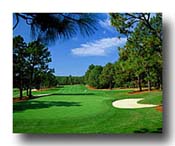PINEHURST / SANDHILLS COURSE GUIDE
|
The Sandhills Were Created for Golf God must have had golf in mind when he created the Pinehurst/Sandhills area of North Carolina. If ever an area was perfect for the game, it has to be these rolling hills with nature's drains built in. So what's a little rain? The sun shines tomorrow and the grass is green and the fairways are manicured and the greens are smooth and rolling true. Come to the Pinehurst/Southern Pines/Aberdeen area for a little golf and get a lot. This is the place where legends not only have played, it's the place where legends were built. There are 43 golf courses in this area, all within a 25 mile radius. There are eight courses located in a four-mile stretch on Midland Road. The names of the architects of the courses on Midland Road alone are worth the trip. When you tee it up in the Sandhills of North Carolina, you are literally walking in the footsteps of some very famous golfers. Ben Hogan won his first professional tournament at Pinehurst in 1940 in the North and South Open. Byron Nelson, Sam Snead and Dr. Cary Middlecoff also won titles there. Jack Nicklaus built part of his legacy with a win in the North and South Amateur when he was a 19-year old in 1959. He returned 16 years later to win the 1975 World Open. Raymond Floyd, who took the highway through his hometown of nearby Fayetteville to get here, won the World Open in 1976 in a one-hole playoff with Jerry Magee, shortly after winning the Masters. While Ross is the most famous of the architects who designed courses in the area, he is surrounded by some pretty good company. Included are Tom Fazio, Rees Jones, Ellis Maples, Robert Trent Jones, Arnold Palmer, Jack Nicklaus, Dan Maples, Tom Jackson, Gene Hamm and Gary Player. Pinehurst No. 2's legendary status was even more firmly entrenched in 1999 when Payne Stewart out-dueled Phil Mickelson and won the U.S. Open in June, then died in a tragic airplane accident a few months later. A statue honoring Stewart's memory adorns the Walk of Fame behind the 18th green on Pinehurst No. 2. Joining him there are statues of Donald Ross, Pinehurst developer Richart Tufts and Robert Dedman, whose company, ClubCorp of America, was responsible for the "rebirth" of Pinehurst when it purchased the resort in 1984. The USGA was so enamored with Pinehurst No. 2 and the area that it brought the Open back to Pinehurst in 2005, where Michael Campbell fought off a charging Tiger Woods down the stretch to claim his first major. The Village of Pinehurst became a National Historic Landmark in 1996, three years before hosting its first U.S. Men's Open Championship in 1999. |
|

 The list includes Donald Ross, Rees Jones, Arnold Palmer, Jack Nicklaus and Dan Maples, who lives here. But just when you thought you had found golf heaven, Midland Road takes you a couple of more miles into Pinehurst. And there sits Pinehurst Resort, with eight more great courses waiting to delight and challenge you. This is great stuff, with a famous old clubhouse that features a hallway of artifacts and memorabilia to take one back to the 1900s when golf was just beginning in the area.
The list includes Donald Ross, Rees Jones, Arnold Palmer, Jack Nicklaus and Dan Maples, who lives here. But just when you thought you had found golf heaven, Midland Road takes you a couple of more miles into Pinehurst. And there sits Pinehurst Resort, with eight more great courses waiting to delight and challenge you. This is great stuff, with a famous old clubhouse that features a hallway of artifacts and memorabilia to take one back to the 1900s when golf was just beginning in the area. There have been two Women's U.S. Opens and two Men's U.S. Opens held here in the past ten years. And for those who think that Pinehurst is limited to 8 courses at Pinehurst Resort, there are 35 more reasons to pack your bags and head for the Sandhills. Pine
There have been two Women's U.S. Opens and two Men's U.S. Opens held here in the past ten years. And for those who think that Pinehurst is limited to 8 courses at Pinehurst Resort, there are 35 more reasons to pack your bags and head for the Sandhills. Pine